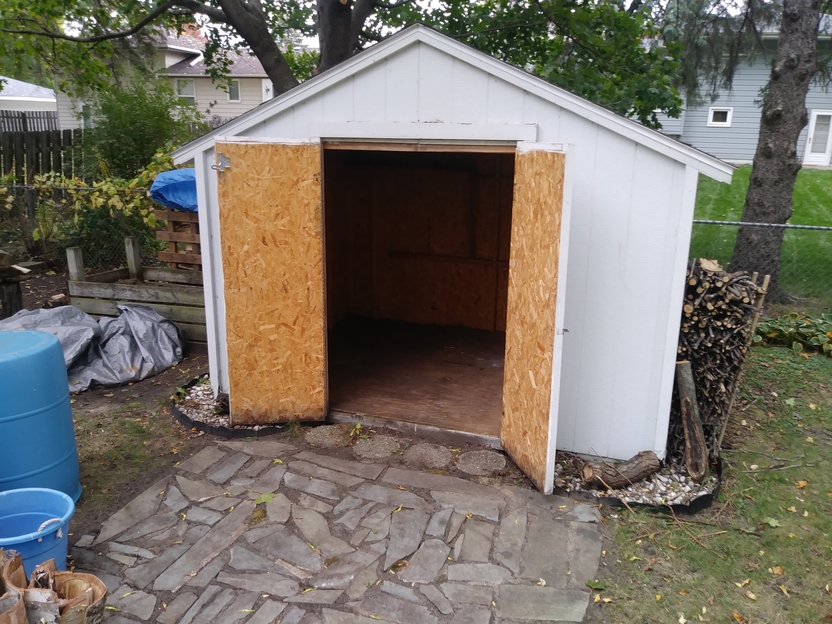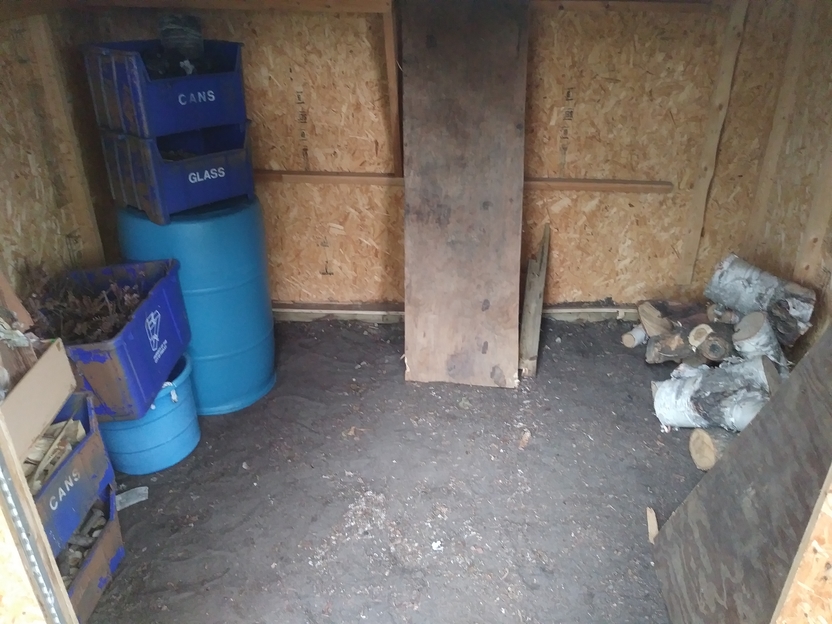-
Posts
172 -
Joined
-
Last visited
Content Type
Profiles
Forums
Articles
Gallery
Downloads
Events
Everything posted by tjdaggett
-

What did you do in the shop today?
tjdaggett replied to Mark Ling's topic in Blacksmithing, General Discussion
Chimaera, the mounting direction is about work surface (horizontal) v energy return (vertical). You get more work done per hammer blow when the track is vertical, but you have less space to work on. It also doesn't take up much space to mount a two foot long piece of track in a stump or stand. -
It is always inspiring to see things like this. Thank you for sharing.
-
Frosty, Good afternoon! The surface area of the steel bit makes mathematical sense, yes, as it does for the coal. I think I will take a very simple step first: sizing down my charcoal. Right now it's mostly in chunks slightly smaller than what you'd get in a bag of grill charcoal, some of it larger. I'll break it into something a little closer to a peanut M&M and see how that burns. From there, we'll try the forge modification.
-
Frosty, I'll take a look and see if the conversion is a possibility for mine. Sounds pretty straightforward. We're finding that if we don't crank with a little oomph the steel heats up sluggishly. This is something I would learn in a good class, which is on my to-do list, but how long should it take to heat up a piece of 3/8" round at full blast? I need to time it. Perhaps YouTube has given me unrealistic expectations!
-
Smiths, Good morning! I fired up the forge with my brother-in-law last Saturday. We're burning charcoal in an old bottom-blast rivet forge. We were testing the limits on the hand-crank, as it has a bad gear. At full blast there was a fountain of sparks issuing forth that went well over my head, 4-5' up from the forge. We need to reduce that fountain. My plan for right now is to go buy some coal through the Guild as I know a bottom-blast setup produces less sparks and burns less fuel when burning coal instead of charcoal. That should get me through the winter, giving my BIL and I time to put together a side-blast to use with charcoal. Good excuse to take a day off and visit the farrier school too. Any other thoughts? I'm looking for tricks I could use to make the current setup less of a fire hazard/hair burner.
-

5 gal bucket retort for making charcoal
tjdaggett replied to elmoleaf's topic in Solid Fuels: Coal, Coke, Charcoal, Wood, etc
I had not thought of elevating the bucket like that and putting the fire under it. I've been nestling cans down in my fire circle and building a fire over and around them. I think your method would let me use a smaller fire and would lower the amount of hands-on attention it requires. I always intend to do yard work/shop work while I burn, and then I get stuck feeding the fire. Am I right in thinking that, in the absence of a good seal, a decent diameter pipe is important? I'm imagining that too small a pipe would encourage the smoke to find the weaknesses in the design and escape, rather than going up the pipe. Is there any kind of heat-proof sealant or epoxy that would form a permanent seal between the pipe and the bucket? I'm not familiar with that stuff yet, just imagining. -
Thanks all! Sounds like the BLO/turps/beeswax is good for general applications and should do alright for the poker. Dad visits often, so I can have him bring the poker if it needs a touch-up.
-
Above it was mentioned that BLO does not stand up well to situations above 90* F. I'm making my father a fire poker for Christmas. Is there something that will keep rust off, not react or deteriorate in fire, and not have him leaving black/greasy handprints on my mother's walls? I'm new to finishes; BLO and pine tar (Torbjorn) are the only two I've seen used. I did see the BLO/turpentine + beeswax combo above, but I'm guessing that would also not stand up to fire.
-

Texas charcoal making
tjdaggett replied to wirerabbit's topic in Solid Fuels: Coal, Coke, Charcoal, Wood, etc
That's something I never imagined: mesquite as a weed. Because of its density I've always assumed it grows slowly. I grew up with Norway pine, birch, and aspen, so far away from mesquite. -

What did you do in the shop today?
tjdaggett replied to Mark Ling's topic in Blacksmithing, General Discussion
I managed to level out the shed floor to my satisfaction on Saturday and lug all of the gear from the garage on Sunday. I've got the anvil stump where I want it, and my work table. Next steps: adjust the leg assembly on the table so there's space to drill holes to bolt on the post vise, then do that, then level out the top of the stump. Then it's time to get to work on dad's poker for Christmas. And of course I'll be figuring out stock storage along the way. -
JPaul, I was working on the forge floor yesterday before I put everything back, and I had to use my sledge to make parts of it workable. That's what I get for using up all the warm months on my garden. Thanks for the knowledge on preheating the anvil. Makes a lot of sense. I've got a piece of metal that will do the trick if I can figure out how to move it with gear on hand. Current plan for the forge: I'm going to keep the rivet forge inside and carry it out when it's time to work. The shed is only 10'x8' and the forge will be about five feet from there, so I shouldn't lose too much heat in transit. Still more than I'd like, but I've got to start somewhere. I also figured out a fun way to get my stump a little higher up (I'm 6"8"). My cousin gave me a semi brake drum to use as a fire pot. I didn't have a good concept of its size when I said yes. It's about 18" across and weighs somewhere in the 125-150 lb. range; WAY too big for my purposes. However, it fits perfectly under my stump, gets it about 1" above ideal height (room to level and fiddle), and has holes in it that will accommodate anchoring bolts to keep the stump from turning. I'll get a picture up before too long. Thanks as always y'all. I think I might have that poker done for my dad's Christmas present after all.
-
TP, sometimes I can't tell if you're serious. Is there risk of cracking the anvil if you bring 2000+ degree steel into contact with its -30 degree face?
-
Salient point that I should have included in the original post: I intend to use this forge during the winter. I garden during the warmer months, so the plan is to make blacksmithing a winter hobby.
-
Smiths, Good morning! I'm considering solving my chimney problem via avoidance and just moving the forge outside. Anvil, vise, table, bucket, etc. would remain in the shed; just the forge would be a few feet outside the door. I'm thinking either a 55 Forge w Turbocharger or a JABOD w chimney TBD. Thoughts? I know that I'm going to lose some heat and efficiency with the slightly greater distance between the forge and the anvil. The alternative is spending several hundred dollars on chimney materials, which isn't an option right now. I'm primarily thinking about how to make the forge last if it's going to sit outside in the MN winter, as well as how to keep it ready to roll with minimum snow removal. Thanks in advance for your logic and experience.
-
Got word this weekend that grandma took a pretty sharp downhill turn. Long story short, there's something wrong with her that only surgery or a miracle could correct, and surgery isn't an option given how weak she is. We're still praying, but I'm getting the impression that we're heading for homecoming rather than healing. Grandpa is meeting with doctors to talk through palliative care options today. Main requests: - That she'd be able to get home so she could have visitors. Right now even grandpa can't be in the hospital room with her due to COVID restrictions. - That those who need to would be able to see her before she goes, and then that she'd go quickly. - That grandpa would be provided for in all the ways he needs. They've been married a little over sixty years. Grandpa is 85 and sharp. Thanks y'all.
-
I'm stuck. So far, I haven't been able to figure out how to legally put a chimney into the shed. Here are the options I've thought of with their respective problems. 1. Put a black, single-walled stove pipe straight up through the roof. These require a minimum clearance of 18 inches between it and combustible materials in order to be up to code. That means a four-foot circle (counting 12" pipe) cut out of my roof. No can do. 2. Do the same, but with double-walled chimney pipe. There are some of these that do not require clearance to combustibles, but their exteriors are mostly galvanized. I don't want galvy hanging over my forge. Also, the bill would be a solid $600 or more, which is right out. 3. Run the chimney out the wall to get the distance from combustibles, then up. This would mean replacing a chunk of my wall (currently plywood) with non-combustible material around the chimney. 4. Look into building a masonry chimney. This seems like a whole other can of worms and would probably require pouring a slab. 5. Make something out of earth. I don't currently have a source for clay, so this seems even more expensive. Some more basic info, which you guys probably already know from my other post: - 8x10 wooden shed - Working in a residential backyard - Good relationships with neighbors and city; want to keep it that way - I have zero welding capabilities, though I could ask if anyone in the local guild could help Thank you for your expertise. Several times you guys have provided the spark I needed for the next step. I really appreciate it.
-
I'm wondering if there is a word in any language for the explosion of fire and scale right after you hit a really hot piece of steel. I'm thinking German or Japanese might have such a word, but it's not something you can really Google. Figured you lot might know.
-

What did you do in the shop today?
tjdaggett replied to Mark Ling's topic in Blacksmithing, General Discussion
Dennis, that looks a heck of a lot like a pair of tongs. Alexandr, that is magnificent. Yesterday I got out in the back yard with my father-in-law and fired up the forge. I straightened a piece of 1/2" round (it came with bent pieces on the ends from its previous life) and drew out one end into a square point. In a couple more afternoons it will hopefully be a fire poker for my dad. This is my first project. Biggest thing I learned: if you leave the ash dump open on a Buffalo rivet forge, your blower can't do its job. Wasted forty-five minutes on that, but I'll never forget it again. Once we closed that thing the roar of the fire became much more satisfying... oh, and effective too. -

Chimney Plan - Looking for Feedback
tjdaggett replied to tjdaggett's topic in Chimneys, Hoods, and Stacks
On Friday I called the building inspector for some guidelines on my forge chimney. This morning he called me back! I was very worried that things were going to get complicated and bureaucratic, but he gave me very concrete, doable steps and useful information. Short version: - Each kind of pipe has as part of its specs a minimum required distance from combustibles (i.e. wall/roof). If I go with double- or triple-walled pipe, that distance goes down. In MN the retailer provides that information, but that I should be fine with standard double-walled. He suggested a sort of double-walled pipe with insulation so I don't burn myself on the chimney, but I think that's less of a concern with my chimney than it would be in a closed wood stove. - The other concern is the distance between the top of the chimney and the peak of the roof. He said my run should put me well out of danger for roof fires. When my questions were answered, he said, "So, what are you going to make?" I gave him my usual spiel about useful, everyday things instead of swords. He said, "That sounds really cool. When you get everything up and running, I'd love to see some of your product." Thus mirroring my conversation with the fire marshal last year. Oh, and did I mention? The building inspector's last name is LeForge. -

Chimney Plan - Looking for Feedback
tjdaggett replied to tjdaggett's topic in Chimneys, Hoods, and Stacks
Bless you George. I needed to be brought back to earth. I'll give the inspector a call tomorrow. If they're anything like the electrical inspector, we'll get along fine. -

Chimney Plan - Looking for Feedback
tjdaggett replied to tjdaggett's topic in Chimneys, Hoods, and Stacks
Honest question: how much do I need to worry about fire code? I don't mean, "How much do I need to worry about fire safety?", I'm just wondering when code comes into play. I have an email from the fire marshal of my town giving me permission to forge in the shed, I'm going to respect my neighbors re: smoke and noise, and I'm going to make sure this forge is good for my neighborhood. When does code become important? When a spark from my forge burns down the next house over? When my roof gets hail damage and the insurance company is looking for a reason not to pay the claim? I'm trying to balance worst case scenarios against the reality that laws aren't written for blacksmiths anymore. They're written for fireplaces, for wood stoves. Even those laws I don't know where to find; I found the website cited earlier utterly incomprehensible. Apologies if my tone is tenser than usual; I would really like to get the forge up and running before we get any serious snow in MN, and I'd like to do it for not more than $200-300, and that goal is being carried off into the sunset by worries about vague but terrible consequences for violating fire code. Note well: Lattincino, I genuinely appreciate you bringing this up. I am just overwhelmed this evening and trying to figure out my next step. -

What did you do in the shop today?
tjdaggett replied to Mark Ling's topic in Blacksmithing, General Discussion
Excellent way to think of it. -
[thread necromancy] Can anyone weigh in on the effect of end-grain wood floors v packed dirt floors on joints? I'm 6'8" and my weight hovers around 300 pounds, so concrete is right out. I plan to start with a packed dirt floor as I don't have any truly heavy equipment yet, except perhaps my stump, and pulling it all out next summer and putting in end-grain wouldn't be terribly difficult. I also need money for wood, which I currently lack. But I'd like to know whether this would be a good investment for the future.
-
I will be praying for you and yours this morning, Charles.
-

What did you do in the shop today?
tjdaggett replied to Mark Ling's topic in Blacksmithing, General Discussion
We got a good deal done this past week. My wife put in a patio (don't know a better word) in front of the forge using stones the previous owner had left stacked in it. It's going to be the closest the kids can stand when watching. Might need to push that further, we'll see. Safety goggles regardless. The shed also came with a plywood floor. I ripped that out on Sunday afternoon. I remembered what y'all said when I asked for safety tips about angle grinders and applied it to the circular saw: if this all goes sideways, where is the saw going to go? I still have all of my arteries. Once I had the floor and joists out, I raked up the remnants of rodent civilization and bagged them up. Found a skeleton or two and a lot of fluff. As a result, I'm one step closer to a fire-resistant floor, and I can access more of the shed without bending over (I'm 6'8", or just north of 2m). I think I gained about four inches of clearance. Next step: acquire the chimney pipe and flashing before snow flies, then give my wife her garage back



